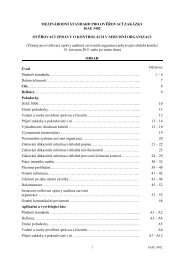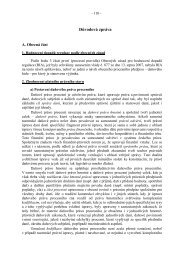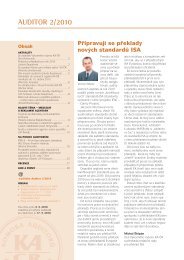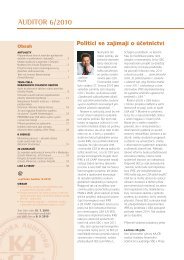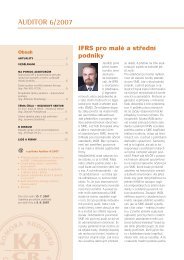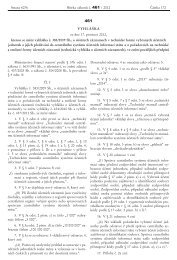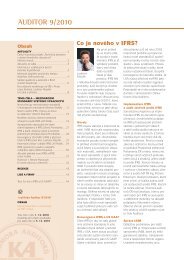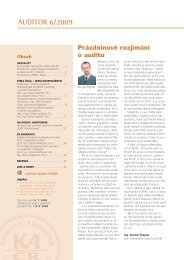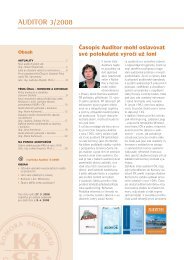Guide to Using International Standards on Auditing in - IFAC
Guide to Using International Standards on Auditing in - IFAC
Guide to Using International Standards on Auditing in - IFAC
You also want an ePaper? Increase the reach of your titles
YUMPU automatically turns print PDFs into web optimized ePapers that Google loves.
80<br />
<str<strong>on</strong>g>Guide</str<strong>on</strong>g> <str<strong>on</strong>g>to</str<strong>on</strong>g> <str<strong>on</strong>g>Us<strong>in</strong>g</str<strong>on</strong>g> <str<strong>on</strong>g>Internati<strong>on</strong>al</str<strong>on</strong>g> <str<strong>on</strong>g>Standards</str<strong>on</strong>g> <strong>on</strong> <strong>Audit<strong>in</strong>g</strong> <strong>in</strong> the Audits of Small- and Medium-Sized Entities Volume 1—Core C<strong>on</strong>cepts<br />
To make the use of asserti<strong>on</strong>s slightly easier <str<strong>on</strong>g>to</str<strong>on</strong>g> apply for audit<strong>in</strong>g smaller entities, this <str<strong>on</strong>g>Guide</str<strong>on</strong>g> has comb<strong>in</strong>ed a<br />
number of the asserti<strong>on</strong>s so that they may apply across all three categories (i.e., balances, transacti<strong>on</strong>s, and<br />
disclosure). The four comb<strong>in</strong>ed asserti<strong>on</strong>s and the <strong>in</strong>dividual asserti<strong>on</strong>s they address are illustrated <strong>in</strong> the<br />
exhibit below.<br />
Exhibit 6.3-1<br />
Comb<strong>in</strong>ed Asserti<strong>on</strong>s Classes of Transacti<strong>on</strong>s Account Balances<br />
Presentati<strong>on</strong> and<br />
Disclosure<br />
Completeness (C) Completeness Completeness Completeness<br />
Existence (E) Occurrence Existence Occurrence<br />
Accuracy and<br />
Cu<str<strong>on</strong>g>to</str<strong>on</strong>g>ff (A)<br />
Accuracy<br />
Cu<str<strong>on</strong>g>to</str<strong>on</strong>g>ff<br />
Classificati<strong>on</strong><br />
Rights and Obligati<strong>on</strong>s<br />
Valuati<strong>on</strong> (V) Valuati<strong>on</strong> and allocati<strong>on</strong> Valuati<strong>on</strong><br />
Accuracy<br />
Rights and Obligati<strong>on</strong>s<br />
Classificati<strong>on</strong> and<br />
Understandability<br />
Note:<br />
When the audi<str<strong>on</strong>g>to</str<strong>on</strong>g>r chooses <str<strong>on</strong>g>to</str<strong>on</strong>g> use comb<strong>in</strong>ed asserti<strong>on</strong>s such as those outl<strong>in</strong>ed above, it is important <str<strong>on</strong>g>to</str<strong>on</strong>g><br />
remember that the accuracy and cu<str<strong>on</strong>g>to</str<strong>on</strong>g>ff asserti<strong>on</strong> also <strong>in</strong>cludes rights and obligati<strong>on</strong>s, and classificati<strong>on</strong> and<br />
understandability.<br />
The follow<strong>in</strong>g exhibit provides a descripti<strong>on</strong> of the four comb<strong>in</strong>ed asserti<strong>on</strong>s used <strong>in</strong> this <str<strong>on</strong>g>Guide</str<strong>on</strong>g>.<br />
Exhibit 6.3-2<br />
Comb<strong>in</strong>ed<br />
Asserti<strong>on</strong><br />
Completeness (C)<br />
Existence (E)<br />
Accuracy and<br />
Cu<str<strong>on</strong>g>to</str<strong>on</strong>g>ff (A)<br />
Valuati<strong>on</strong> (V)<br />
Descripti<strong>on</strong><br />
Everyth<strong>in</strong>g that should be recorded or disclosed <strong>in</strong> the f<strong>in</strong>ancial statements has been<br />
<strong>in</strong>cluded.<br />
There are no unrecorded or undisclosed assets, liabilities, transacti<strong>on</strong>s, or events;<br />
there are no miss<strong>in</strong>g or <strong>in</strong>complete f<strong>in</strong>ancial statement notes.<br />
Everyth<strong>in</strong>g that is recorded or disclosed <strong>in</strong> the f<strong>in</strong>ancial statements exists at the<br />
appropriate date and should be <strong>in</strong>cluded.<br />
Assets, liabilities, recorded transacti<strong>on</strong>s, and other matters <strong>in</strong>cluded <strong>in</strong> the f<strong>in</strong>ancial<br />
statement notes exist, have occurred, and perta<strong>in</strong> <str<strong>on</strong>g>to</str<strong>on</strong>g> the entity.<br />
All liabilities, revenues, expense items, and rights <str<strong>on</strong>g>to</str<strong>on</strong>g> assets (<strong>in</strong> the form of a hold or<br />
c<strong>on</strong>trol) are the property or obligati<strong>on</strong> of the entity and have been recorded at the<br />
proper amount and allocated (cu<str<strong>on</strong>g>to</str<strong>on</strong>g>ff) <str<strong>on</strong>g>to</str<strong>on</strong>g> the proper period. This also <strong>in</strong>cludes proper<br />
classificati<strong>on</strong> of amounts and disclosures <strong>in</strong> the f<strong>in</strong>ancial statements.<br />
Assets, liabilities, and equity <strong>in</strong>terests are recorded <strong>in</strong> the f<strong>in</strong>ancial statements at the<br />
appropriate amount (value).<br />
Any valuati<strong>on</strong> or allocati<strong>on</strong> adjustments required by their nature or applicable<br />
account<strong>in</strong>g pr<strong>in</strong>ciples have been appropriately recorded.




